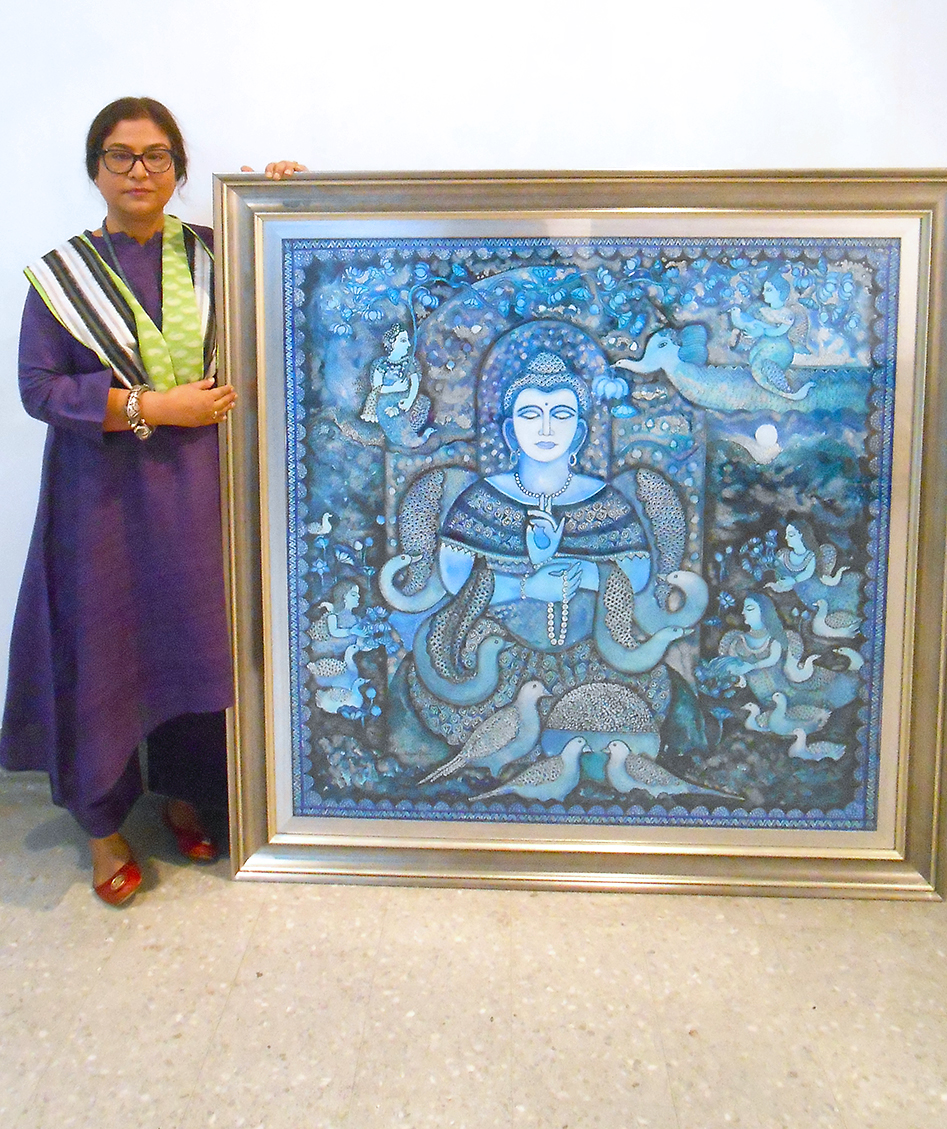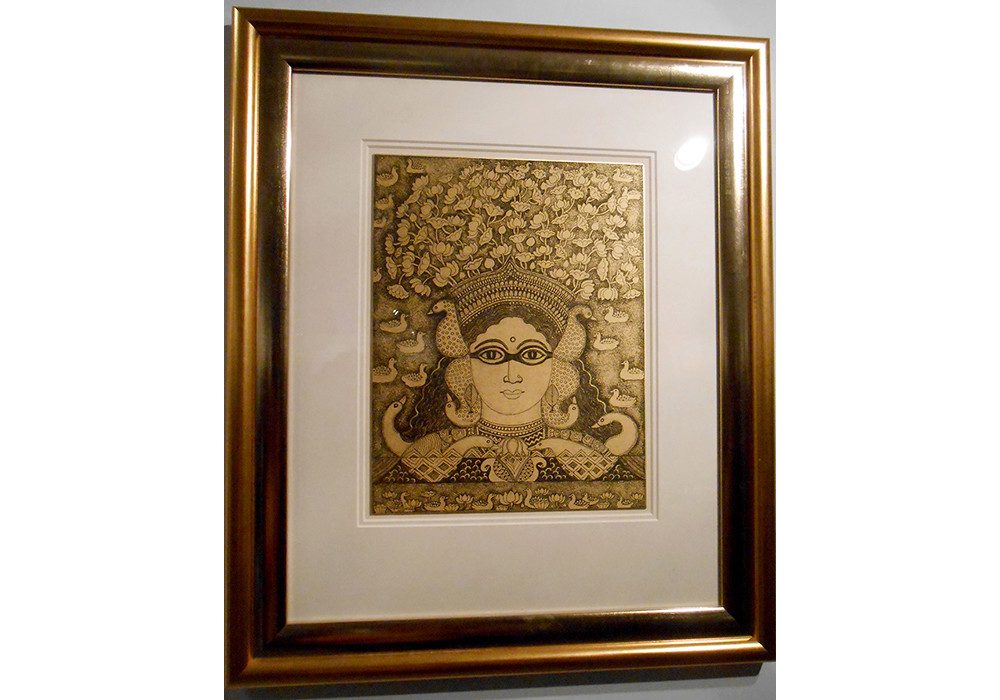Jayasri Burman’s paintings capture both the strength and tenderness of the modern woman, writes Aratrika Halder.
I love Kolkata and I am really looking forward to their reactions to my exhibition,” says Jayasri Burman, a little nervously. A sense of pride is visible in her playful eyes that hide behind thick-rimmed black glasses as she looks around at her paintings. “For an artist, his or her environment is everything. Everything fascinates me and I try to find a subject from all that I see. In fact I am even inspired by you,” she says with a shy smile.
Painting has been her first love, says Burman, from a very small age. Just like any other Bengali family, her parents tried coaxing her into learning classical dance. But the routine and rules made her feel claustrophobic. “The moment I saw the teachers scolding the students for not following the rhythm of ta thei thei ta, I felt claustrophobic, as if someone is trying to chain me up and make me learn something forcefully.” But when I mention that even her paintings must have needed practice and following of rules, she quickly adds, “Painting is something that comes from within me. So no matter how much rules and regulations I have to follow, I can never leave it.”
The year 1996 was when Burman’s real struggle began. By then she had decided that she wanted to pursue her art further and wanted a career in painting. So she left her home in Kolkata and came to Delhi with high hopes. “When I came to Delhi, I had nowhere to go. I didn’t know where to start from. All of a sudden I had broken down all the walls and entered the real world from which my family had protected me for so long. But I was a headstrong woman and I wanted to work. My close friends all knew this fact, and so they helped me out a lot. They gave me opportunities for which I will be always grateful to them.”
“I was so mesmerised by the unseen that I wanted to see it all,” she says. “I wanted to take in as much as possible and then paint them on my canvas. That one year gave me experiences worth ten years.”
The same year, she started travelling a lot. “I was so mesmerised by the unseen that I wanted to see it all,” she says. “I wanted to take in as much as possible and then paint them on my canvas. That one year gave me experiences worth ten years.” From Orissa to Rajasthan, south India to Kullu-Manali in the north, she didn’t leave any stone unturned in search of inspiration.
But that hasn’t changed her love for her own city, Kolkata. Amidst the tall and lifeless buildings and malls, she still manages to draw inspiration from the city’s old-world charm. “Being born and brought up in a Bengali family, I was always fascinated at how the British culture still continued to influence the people here. Even now young people choose to go and visit film festivals, and save their pocket money to buy books at the annual book fair.”
Those aren’t the only things that inspire her. Most of her paintings are inspired by the goddess Durga and her other avatars. The cloud-like motifs and the occasional half-duck and half-human figures are all her attempts of keeping up with the age old traditions that her grandmother and mother has passed onto her. In fact, she admits that when she was little, all those fairytales and stories of mythological prince and princesses had affected her in a very deep way. And as she grew up, she began to identify Mother Nature with these deities and stories with. For her, nature is a caring and nurturing mother, but she can also be a malevolent force like the Goddess Kali.
Though she hates being labelled as a feminist, most of her paintings have strong women characters, who are bold and modern. “I want my paintings to be a source of inspiration for all the women out there,” she says.
In our male-dominated society, Burman sees women in a very different light. Though she hates being labelled as a feminist, most of her paintings have strong women characters, who are bold and modern. “I want my paintings to be a source of inspiration for all the women out there,” she says. “If I start drawings pictures of girls hiding behind the curtains, crying and hurt, the women seeing my paintings will only get negative vibes from the picture. But when the girl becomes a powerful figure of the goddesses, or when I paint a pair of wings for that girl to fly beyond the worldly entrapments, the women who see my paintings feel more confident, empowered and free.”

Burman’s paintings are more often than not done on huge canvases, which are colourful, vibrant and so detailed that even after a thorough look at her paintings, one will always find something new at to look at the next time. And though she is proud of them, she also expresses her fear of not being able to do it for long, as age is soon going to catch up with her. “When I am doing my paintings there are times when for several days I don’t come out from my studio. And this takes toll on my health, as often after finishing the piece, I end up with a swollen wrists and knees.” But all this trouble is worth going through, because when she paints she gets transported to the world of her mythological characters, where women are both intellectual and strong, and also soft and full of charm.
But does having an artist for a husband help her in any way? “No, not really,” Burman replies with a shy smile, “but yes, there are times when I talk to him about my ideas and he too wants my opinions regarding his sculptures. We both respect each other’s style and don’t want to be too much of an influence for each other, but it is nice to have someone as your partner who has the same mindset like your own.”
Does having an artist for a husband help her in any way? “No, not really,” Burman replies with a shy smile, “but yes, there are times when I talk to him about my ideas and he too wants my opinions regarding his sculptures.”
Talking about family, in many an interview she has been repeatedly asked about her uncle Sakti Burman and since both of their paintings resonates the same characters of Indian mythology, more often than not, her paintings have been said to have been just a slight variation from that of her uncle’s. “Well, I cannot help it if people have such preconceived notions about my art. But in my defence, I would like to say that my uncle has a very different thought process to his paintings. He stays in Paris and for him, his characters are a part of the fairytale world that he lives in. I take my inspirations from the more earthy and rustic side of the world. So while my characters are much more expressive and connect with the real world more effortlessly, my kaku’s paintings are mostly inspired from the realm of fairytales.”
She also admits that this insufficient knowledge among the people hinders her growth as an artist. While many people believe that having a mid-career retrospective at this stage isn’t appropriate, Burman believes that in order for others to understand her journey and her various evolutions in her paintings, she needs to showcase her old as well as some her new paintings and sculpture in this exhibition. “When I first pitched the idea of having this mid-career retrospective, many had questioned it. Mostly they thought that it was unnecessary and that I still hadn’t reached such heights in my career after which I can have a mid-career retrospective. Of course, if I wanted, I could have easily showcased my recent works and sold them off. But where is the satisfaction in that? As a painter, I want my art to resonate what I feel inside and I also want my audiences to connect with it, and this retrospective shows my growth from 1996 which the most difficult year in my entire life.”
The exhibition also launches her book, Antaryatra; as the name suggests, the book traces her journey and evolution as a painter through the past 20 years. “This is my first solo exhibition in Kolkata and I am excited to see how my own people will react to this. It matters to me a lot, as their response might make or break this exhibition. But I know I’ll get to learn a lot from my audiences.”
“If I wanted, I could have easily showcased my recent works and sold them off. But where is the satisfaction in that? As a painter, I want my art to resonate what I feel inside and I also want my audiences to connect with it”.
The book has been curated by Ambica Beri, founder of Gallery Sanskriti. “I have really enjoyed working with Ambica,” says Burman, “because we have always worked on the same space. We did it in perfect harmony and she always understood my reasons and tried working accordingly.” She also was extremely grateful towards Pritish Nandy for writing poems for all of her 14 sculptures that have been included in her book. “Though this book has paintings and sculptures by me, it is my belief that Pritish Nandy’s contribution for my book is beyond any comparison and I don’t know how to praise him enough for this.”
Antaryatra also features a foreword written by Amitabh Bachchan, for which she is extremely thankful to him. “I cannot tell you how happy I am to be associated with this family. Jayadi [Jaya Bachchan] has always praised my art and she also owns a lot of my pieces. So I thought of asking Mr Bachchan to write a foreword for my book and he agreed to it almost immediately. He was so punctual in sending the piece to me that I was really surprised.”
Nineteen ninety six wasn’t the only year that had affected the painter. The year 1984 proved to be equally important for Burman, when her uncle, Sakti Burman, took to Paris with him for the first time. There they both met Monsieur Ceizerzi, a renowned printmaking artist, and he instantly took a liking to young Burman.
Neither of them knew how to communicate with each other, but art was the one thread that kept them both together. Burman admits that without knowing his print-making techniques she would not have learnt perhaps the most important thing required for her paintings—cleanliness and accuracy.
Neither of them knew how to communicate with each other, but art was the one thread that kept them both together. Burman admits that without knowing his print-making techniques she would not have learnt perhaps the most important thing required for her paintings—cleanliness and accuracy. Also, after visiting museums and galleries, she felt heartbroken and dejected. But instead of giving up she gave her paintings everything she had. She started painting in an impressionistic style and did huge oil paintings. Slowly but steadily, her style improved and she started experimenting on her own. “Now whenever I paint, I let the colours build on canvas freely rather than restricting it to a shape or a mould.”
And over time, she has developed a unique style of her own. Inspired by folk art and Indian mythology, Jayasri Burman tries to create her own world of contemporary modernity, with hints of traditional rituals and customs strewn here and there. Though her paintings portray strong women, the essential sentiment in them is soft and whether they are shown content with the bounties of life or free and in harmony with nature, they are compassionate as a mother goddess, an inspiration for women all over the world.














